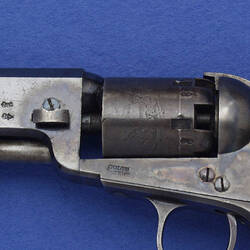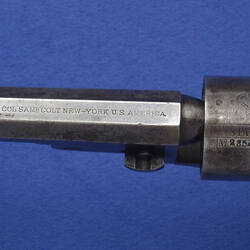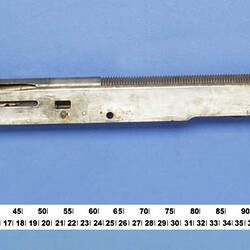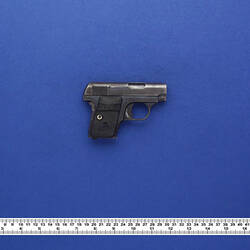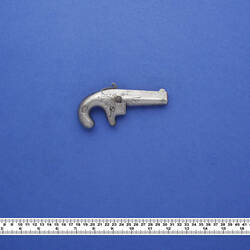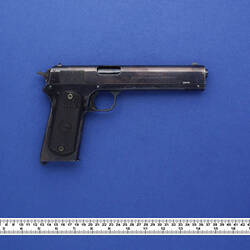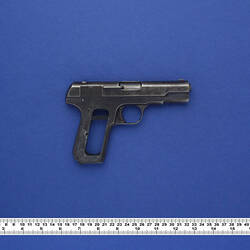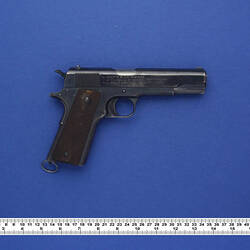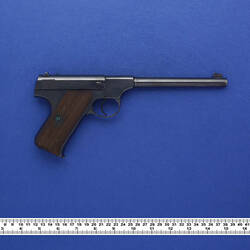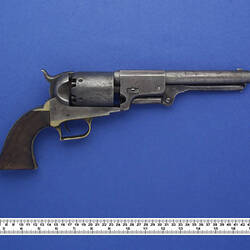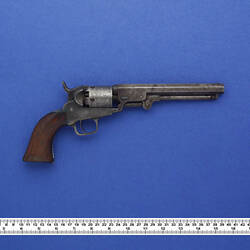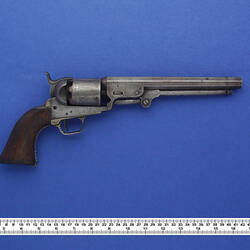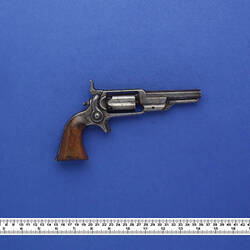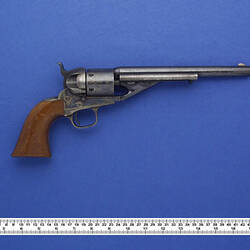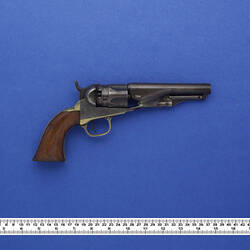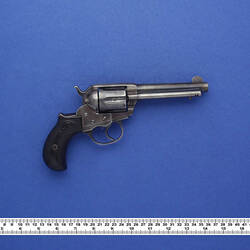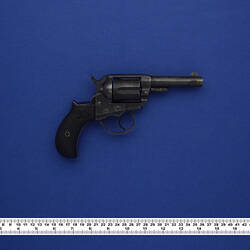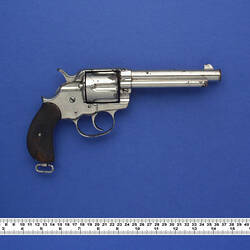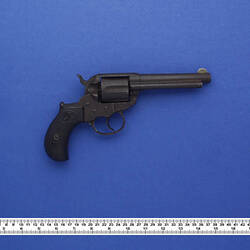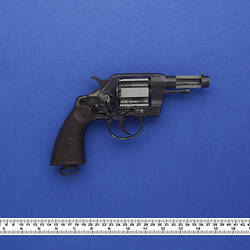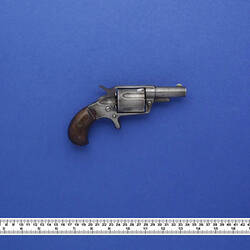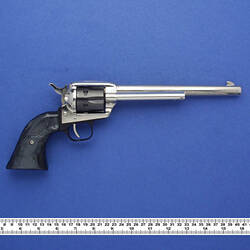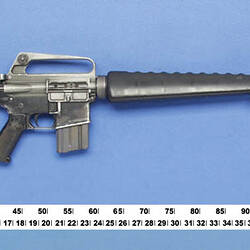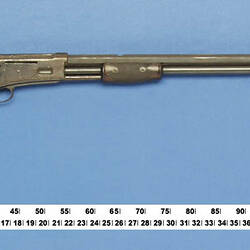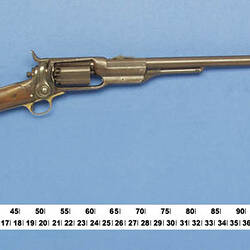During the early 1830s Samuel Colt developed the idea of a revolving firearm which would enable a rotating cylinder to contain several rounds, rather than just the one single-shot, then common to all firearms. This period is discussed in slightly greater detail in Colt's individual party record, but it is sufficient to say that so successful were these advancements in firearm design that by 1836 the state of New Jersey chartered the first Colt firm, known as the Patent Arms Manufacturing Company. A sales office and showroom were established at 155 Broadway, New York City. Colt's contract specified that he had a hand in nearly all aspects of the company: salesman, consultant designer, engineer, and occasional demonstrator.
The early years however were sluggish and plagued with several problems. First amongst them was the unperfected nature of Colt's prototype models which, while working well in the hands of their inventor, did not always perform so optimally in the hands of others. The delay of some eighteen months between the initial marketing, and the favourable publicity this generated, and the realisation of actual working products was another. Colt had anticipated a ready market for his revolving firearms, both in government as well as civilian circles, but when the products finally reached retailers the reception was more mixed.
The depression of 1837 and various internal problems with the company - abbreviated by Colt to P.A. Mfg. Co. - resulted in the business ceasing operations in 1842. The company's treasurer, John Ehlers (a former friend of Colt's who would later be described as a 'rogue') as the major creditor, had his claims in the company settled first when operations ceased. This meant that he obtained legal rights to the vast majority of some 820 completed firearms of various models, and 500 uncompleted firearms, predominantly handguns. While Colt's involvement in the business been anything but financially profitable to date, Ehlers - drawing from his newly acquired stock - made sizeable sales to the US Navy in 1845 which proved financially rewarding.
Colt's fortunes changed in 1846. Captain Samuel Hamilton Walker, a veteran of the Texan and Mexican Wars and a national hero, came east seeking an improved revolver for use by the Texas Rangers. Several captains in the Texas Rangers had had experience with Colt's earlier revolvers and found them favourable. Walker, after arriving in New York, was soon in contact with Colt discussing arms purchases. The result of their discussions, and the subsequent year's work in establishing a factory at Hartford, Connecticut, was the 1847 Colt Walker.
Following the Mexican War of 1848, a series of events thrust Colt's firearms to the fore. In the same year, gold was discovered in California, prompting renewed expansion westwards from the eastern states. The discovery of gold in Australia a few years later, just as the Californian rush began to subside, provided another ready market for firearms, for both Americans and Europeans heading south. Colt had exhibited at the Great Exhibition in London in 1851, and was developing a reputation for presenting influential individuals involved in government and the arms industries with beautifully adorned presentation examples - a practice which was called into question on several occasions.
The Pocket model of 1849, and the larger Navy 1851 model, quickly became recognised as the desirable firearm of choice - the former being so popular that production ran for almost 25 years. Colt's early death in January 1862 brought an end to one phase of the business' operations, but heralded the beginning of another. Colt's wife turned to her husband's close friend, Elisha Root, who succeeded Colt as President - for only three years. His untimely death in July 1865 resulted in a third President in less than five years. Richard W.H. Jarvis, Mrs Colt's brother, followed Root, and was the President until 1901.
In early February 1864 a disastrous fire, often cited as due to Confederate sabotage, swept through a major portion of the factory, causing severe damage and destruction to equipment, machinery, records, design drawings and stock estimated at US$1,200,000. Not until the mid-1930s would the company suffer a similar devasting loss. Mrs Colt, determined to see her husband's legacy continue, sought to have the factory rebuilt irrespective of the cost. Those buildings not damaged quickly resumed production, but the end of the Americal Civil war in 1865 brought about another slowing down of output and the decreased pace of production brought about a recession in the firearms industry. The rebuilt Colt factory still stands facing the Connecticut River and the star-studded dome was restored in 1976 by an anonymous benefactor.
While the first half of the nineteenth century had centered around the evolution from flint to percussion ignition systems, and the development of multi-shot firearms in the form of Colt's revolvers, the second half of the century witnessed the very rapid development beginning in the late 1860s of metallic cartridge ammunition and, by the end of the century, smokeless ammunition. Noted Colt historian and author, James Severn, has written that 'Colt policy appeared to be one of constant experimentation and change, variations in markings alone would fill a substantial volume. In Colt production, for every rule there will be found exceptions'.
The popular 1851 Navy models were beginning to be converted to accept the new cartridge ammunition. In Australia, the conversion of the Victoria Police's 250 Colt Navy revolvers was undertaken by well-known local gundealer, James Rosier, based on the Thuer conversion (pat. 15 September 1868). The conversion had been the inspiration of another Colt employee, and close friend of Colt's before his death, Prussian Alexander Thuer. Thuer had joined Colt in 1849, having learned the gun trade in his native Germany, and was regarded as an excellent marksman who often accompanied Colt on shooting demonstrations. Other conversions followed - the Richards conversion patent of 25 July 1872; the Richards-Mason conversion patent of 25 July 1871 and 2 July 1872 among others.
In 1873 the model that would become renowned worldwide for its associations with cowboys emerged - the 1873 Single Action Army (SAA) revolver. It grew to have various names attached to it: 'Frontier', 'Peacemaker', 'Six-shooter'. It continued throughout the twentieth century and into the twenty-first as one of the more popular, classical models.
Single action revolvers - as their names suggest - involve only one action to fire them. The hammer is cocked manually by being raised by the shooter, before depression of the trigger throws it forward to fire. By the late 1870s double-action - or 'self-cocking' - revolvers were beginning to appear, where pulling the trigger had the combined effect of both raising and dropping the hammer sequentially.
Colt consistently reacted to gaps or new introductions to the market, reflecting an entrepreneurialism that continues to be recognised in the company today. Having mastered the double-action system, Colt set their sights on providing an improvement to competitor Smith & Wesson's simultaneous ejection system.
William Mason, noted above for his association with the Richards-Mason conversion to metallic cartridge ammunition in the early 1870s, set to work and a series of patents taken out throughout the mid 1880s resulted in the 1889 Colt Double Action (DA) Navy revolver with a swing-out cylinder, physically resembling the DA Army model of almost a decade earlier. The model was short lived, being produed for only three years between 1889 and 1892, but a feature had been developed which would from now on appear as a standard feature on nearly every Colt revolver produced hereafter.
The DA Army remerged shortly after production had ceased in the form of the New DA Army and Navy revolvers, with various sub-models being produced from 1892 through to 1903. At the same time, various other models sharing the basic features now being incoporated in the New DA revolvers appeared: the New Service revolvers, the pocket models - the New Pocket, and the Pocket Positive, and the police models in the form of the New Police and Police Positive among others.
By 1926 the New York Police Department had adopted the successor to the New Army model and shortly after, with various other Police Departments adopting the model, it reappeared under the new designation of the Official Police model.
The stock market crash in 1929 and the following Depression years resulted in a slowing down of production, and a decline in morale which in turn prompted the great strike of 1935, the worst in the company's history. At the height of the strike a bomb was detonated on the front verandah of company president Sam Stone's house. Although the strike was resolved after several months, neither side emerged victorious.
Almost as soon as the company began to right itself following the strike, the factory was hit by a hurricane and flood in 1936 causing damages estimated at more than $1,000,000. One employee, and a later company historian, Ron Wagner, recalls boats being rowed through the factory's windows on salvaging excursions. Robert Courtney, Wagner's superior, had the foresight to rescue the company's shipping ledgers, but loss to other records, machinery, parts, real estate and finished guns was substantial.
Alongside the company production of revolvers, a new direction had been taken at the end of the 19th century with the introduction of the Model 1900 - the company's first automatic pistol, principally the brain-child of another highly recognised inventor/designer, John M. Browning. Colt was the first US manufacturer of automatic pistols - and fostered the reputation throughout the first decade of the century through various improvements until the well-known 1911 Colt Automatic appeared. This model, in various guises, continues today as the basic shape for not only Colt's automatic pistol range, but many of its competitors.
References:
Haven, Charles and Belden, Frank (1940). A History of the Colt Revolver and other arms made by Colt's Patent Fire Arms Manufacturing Company from 1836 to 1940, William Morrow & Co., New York.
Severn, James (1952). Colt Cartridge Pistols, self-published, California.
Wilson, R. L. (1985). Colt - An American Legend: The Official History of Colt Firearms from 1836 to the Present, Abbeville Publishing Group, New York, London.
More Information
-
Keywords
-
Localities
-
Authors
-
Article types

